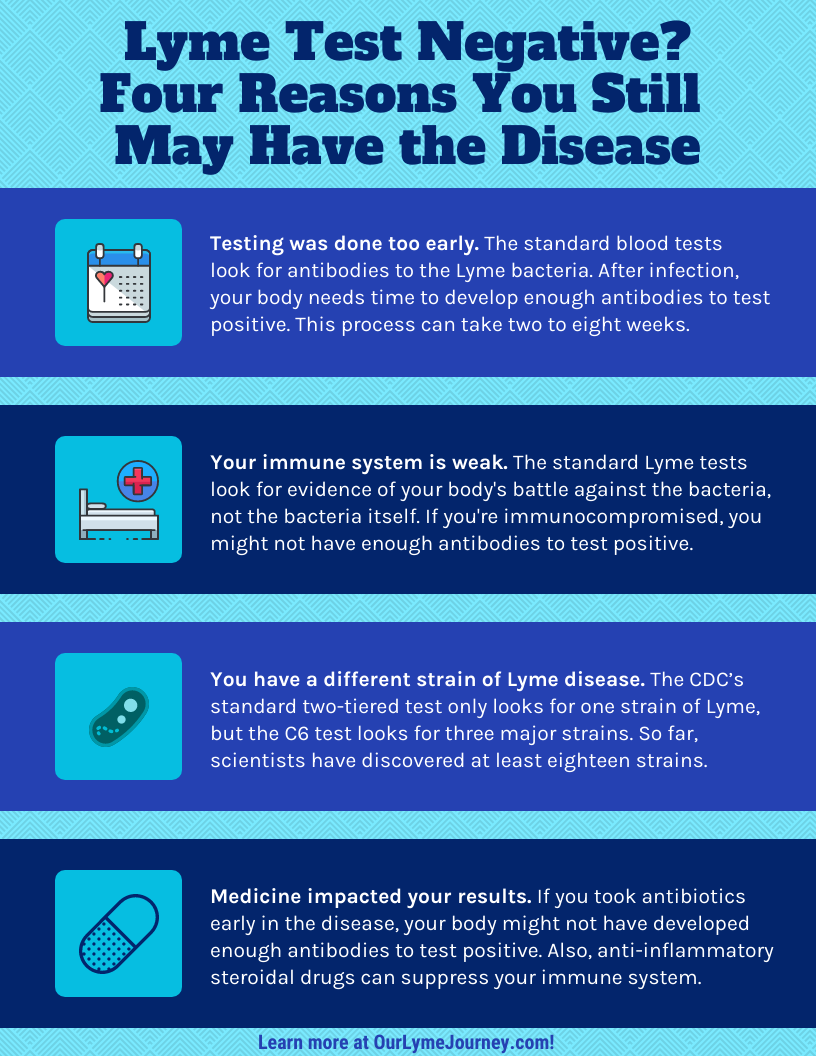Was your Lyme Antibody (Ab) Screen negative, but you still think you may have the disease? Then read on to discover four reasons you could have gotten a false negative.
1. You completed the Lyme Ab Screen too early.
The standard two-tiered blood testing looks for antibodies to the Lyme bacteria. The first test—the Lyme Ab Screen—is usually an ELISA (enzyme-linked immunosorbent assay).
In Conquering Lyme Disease, Fallon and Sotsky write, “False negative rates on the ELISA have been reported as high as 67 percent in early Lyme…”
Not to overstate the obvious, but that’s more than half the people who have early Lyme. In fact, it’s closer to three quarters. And they’re getting a negative result on the supposed-to-be-sensitive screening test!
To make matters worse, if you test negative—and don’t notice a rash—many doctors will conclude you don’t have Lyme. No further testing will be completed.
One reason for the high false negative rate in early Lyme is that your body needs time to develop antibodies. Developing enough antibodies to test positive can take two to eight weeks. As a result, if you test before or during that time, you could get a false negative.
But, even if you test eight weeks or more after infection, you can still get a false negative. That brings us to our second reason.
2. Your immune system is weak.
The standard Lyme tests look for evidence of your body’s battle against the bacteria. They don’t look for the actual bacteria. If your immune system is compromised, you might not have enough antibodies to test positive. Immunocompromised patients come in several varieties:
- Seronegative patients who don’t produce antibodies.
- Patients whose immune systems are weakened due to another illness.
- Patients whose immune systems are suppressed from tick saliva.
As IGeneX says, “The saliva of infected ticks contains specific immune-suppressing components that can delay or prevent the activation of a person’s immune response.”
But even if you didn’t test too early, and you don’t have a weak immune system, you could still test negative. Why?
3. You have a different Lyme strain.
The standard test looks for only one strain of Lyme. In contrast, the C6 test, looks for three. So far, scientists have discovered at least eighteen strains.
Let’s say you tested late enough, your immune system is strong, and you have the most common Lyme strain. Can you still get a false negative? Unfortunately, yes. That brings us to our fourth reason.
4. Medicine impacted your results on the Lyme Ab Screen.

If you took antibiotics early in the disease, your body might not have developed enough antibodies to test positive.
Fallon writes, “If a person has been given antibiotics early in the course of infection, the immune response may be partially blunted as the spirochetal load is less, resulting in a false negative ELISA…”
Similarly, anti-inflammatory steroidal drugs can suppress your immune system. Even nonsteroidal anti-inflammatory drugs (NSAIDs) can weaken it.
So, we’ve now discussed some ways the Lyme Ab Screen can fail. But what about the second part of the standard test—the western blot? Read about the two band controversies here!





Pingback: Which Lyme Tests Should You Ask Your Doctor to Order? - Never Alone
Pingback: Why the Tests for Lyme Disease Flunk - Never Alone
Pingback: The Lyme Blood Test: Band Controversies (Not the Beatles) - Never Alone
Pingback: IGeneX Lab: Sensitive Lyme and Co-infections Testing - Never Alone